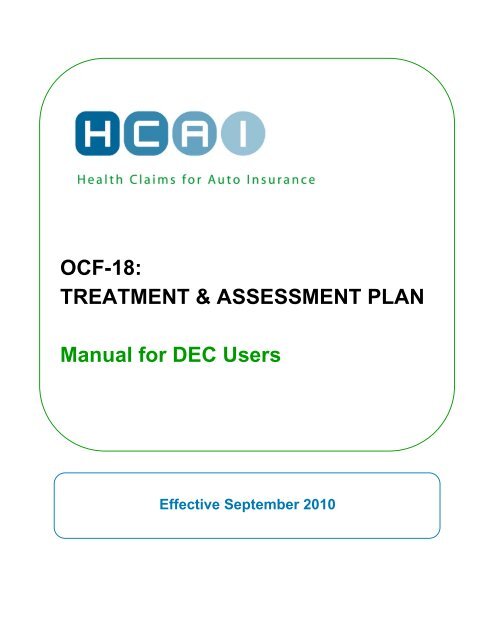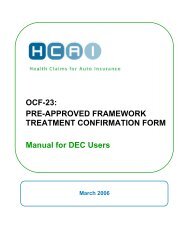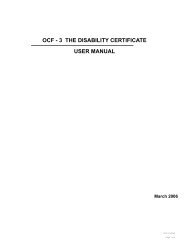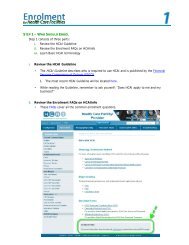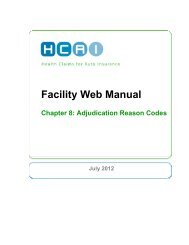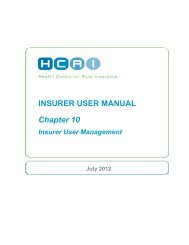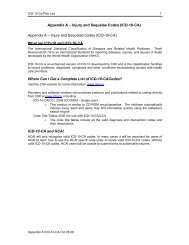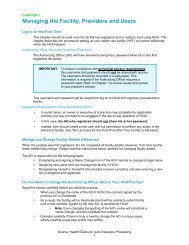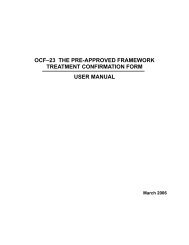OCF-18: TREATMENT & ASSESSMENT PLAN - Manual for ... - HCAI
OCF-18: TREATMENT & ASSESSMENT PLAN - Manual for ... - HCAI
OCF-18: TREATMENT & ASSESSMENT PLAN - Manual for ... - HCAI
You also want an ePaper? Increase the reach of your titles
YUMPU automatically turns print PDFs into web optimized ePapers that Google loves.
<strong>OCF</strong>-<strong>18</strong>:<br />
<strong>TREATMENT</strong> & <strong>ASSESSMENT</strong> <strong>PLAN</strong><br />
<strong>Manual</strong> <strong>for</strong> DEC Users<br />
Effective September 2010
Table of Contents<br />
DOCUMENT CHANGE HISTORY...........................................................................................................................2<br />
INTRODUCTION.........................................................................................................................................................3<br />
WHERE CAN I GET MORE INFORMATION? .......................................................................................................3<br />
SAMPLES OF COMPLETED SECTIONS OF THE FORMS .....................................................................................3<br />
WHEN DO I USE AN <strong>OCF</strong> <strong>18</strong> INSTEAD OF AN <strong>OCF</strong> 23 (PAF OR MIG CONFIRMATION) .....................................3<br />
WHO COMPLETES THIS FORM TO PREPARE IT FOR SUBMISSION TO THE INSURER?............................................3<br />
WHO HAS TO SIGN THE <strong>OCF</strong> <strong>18</strong>?..................................................................................................................3<br />
HOW DO I KNOW THE DATA ENTRY CENTRE (DEC) RECEIVED MY FORM? .......................................................3<br />
HOW DO I KNOW THE DEC SUBMITTED MY FORM TO THE INSURER? ................................................................4<br />
WHAT IS THE ROLE OF THE DEC IN MY ELECTRONIC SUBMISSION? .................................................................4<br />
WHAT IS THE INSURER’S ROLE? ...................................................................................................................4<br />
WHAT IF THERE IS TO BE SIMULTANEOUS <strong>TREATMENT</strong> BY MULTIPLE HEALTH PROVIDERS IN THE SAME HCF? .....4<br />
FORM COMPLETION FEE ..............................................................................................................................4<br />
COMPLETION OF AN <strong>OCF</strong> <strong>18</strong> FOR <strong>HCAI</strong> DEC PROCESSING.......................................................................5<br />
CLAIM IDENTIFIERS – SPEED UP CLAIMS PROCESSING...................................................................................5<br />
Four Key Identifiers .............................................................................................................................................5<br />
PART 1 APPLICANT INFORMATION ...............................................................................................................6<br />
PART 2 INSURANCE COMPANY INFORMATION .........................................................................................6<br />
Independent Adjusting Companies and Adjusters..........................................................................................6<br />
PART 3 OTHER INSURANCE INFORMATION ...............................................................................................6<br />
PART 4 SIGNATURE OF HEALTH PRACTITIONER .....................................................................................7<br />
IF YOUR HCF REQUIRES AN EXTERNAL (NOT ASSOCIATED) HEALTH PRACTITIONER’S SIGNATURE IN PART 4......8<br />
Health Practitioners .............................................................................................................................................8<br />
Regulated Health Professionals ........................................................................................................................8<br />
What is an “Associated Provider” ......................................................................................................................8<br />
PART 5 SIGNATURE OF REGULATED HEALTH PROFESSIONAL..........................................................2<br />
“Is the health practitioner also the regulated health professional?”..............................................................2<br />
PART 5 – <strong>PLAN</strong> SUPERVISION.......................................................................................................................2<br />
When and why is a Signature Required in Part 5?.........................................................................................3<br />
PART 6 INJURY AND SEQUELAE INFORMATION.......................................................................................3<br />
QUESTIONS ABOUT CODING?........................................................................................................................4<br />
Coding Tips:..........................................................................................................................................................4<br />
PART 7 PRIOR AND CONCURRENT CONDITIONS......................................................................................5<br />
PART 8 ACTIVITY LIMITATIONS.......................................................................................................................6<br />
PART 9 <strong>PLAN</strong> GOALS, OUTCOME EVALUATION METHODS AND BARRIERS TO RECOVERY .....6<br />
PART 10 SIGNATURE OF APPLICANT .............................................................................................................7<br />
PART 11 HEALTH CARE PROVIDERS ..............................................................................................................8<br />
PART 12 PROPOSED GOODS AND <strong>TREATMENT</strong> SERVICE.......................................................................8<br />
Goods/Service Reference (G/S)........................................................................................................................8<br />
Description............................................................................................................................................................9<br />
CODE AND ATTRIBUTES................................................................................................................................9<br />
PROVIDER REFERENCE ................................................................................................................................9<br />
Multiple providers delivering one services .......................................................................................................9<br />
ESTIMATED..................................................................................................................................................9<br />
Projected Total Count .......................................................................................................................................10<br />
Projected Total Cost..........................................................................................................................................10<br />
Totals...................................................................................................................................................................10<br />
Attachments........................................................................................................................................................10<br />
PART 13 SIGNATURE OF INSURER ................................................................................................................11<br />
1
Document Change History<br />
Date Description of Change Reason<br />
20050214 Revised Signature of Health Practitioner &<br />
Applicant Signature, Repositioned Signature of<br />
Insurer<br />
20060301 Revised Further In<strong>for</strong>mation, Who completes<br />
<strong>for</strong>m, Other Insurance In<strong>for</strong>mation, Signature of<br />
Health Practitioner & Regulated Health<br />
Professional and Health Providers<br />
2009 To be inserted<br />
20100614 Form name change, Remove Part 4,<br />
Renumber the part numbers, GST field<br />
renamed TAX and PST field removed.<br />
For consistency with revised <strong>OCF</strong> <strong>for</strong>ms<br />
01/Dec/04<br />
Redirects users to <strong>HCAI</strong> website <strong>for</strong><br />
further in<strong>for</strong>mation and reflects inclusion<br />
of Social Worker as per revised SABS<br />
Changes as of September 1, 2010<br />
2
Introduction<br />
An <strong>OCF</strong> <strong>18</strong> is used to propose assessments, goods or treatments to an automobile insurance company<br />
<strong>for</strong> the purpose of seeking approval of funding <strong>for</strong> the goods and/or services. An <strong>OCF</strong> <strong>18</strong> may be used to<br />
propose an assessment only, treatment only or both at the same time. Speak with the insurer if you are<br />
uncertain how to proceed.<br />
Where can I get more in<strong>for</strong>mation?<br />
Visit the www.hcaiinfo.ca website <strong>for</strong> additional in<strong>for</strong>mation. If you are unable to locate the in<strong>for</strong>mation,<br />
you should contact your health professional association or organization with questions relating to coding<br />
of injuries, interventions, health care services and guidelines as they relate to your specific practice.<br />
Samples of Completed Sections of the Forms<br />
The samples and fees used throughout the manual are entirely fictitious. They are designed to<br />
assist you in understanding how to use and complete the <strong>for</strong>ms.<br />
When Do I Use an <strong>OCF</strong> <strong>18</strong> Instead of an <strong>OCF</strong> 23 (PAF or MIG Confirmation)<br />
• <strong>OCF</strong> <strong>18</strong>s should be used to propose health assessments, goods and services <strong>for</strong> patients with<br />
injuries that are NOT suitable <strong>for</strong> treatment in a Pre-Approved Framework (accidents be<strong>for</strong>e<br />
September 1, 2010 with WAD I & II) or in the Minor Injury Guideline (accident date on or after<br />
September 1, 2010 with Minor Injury(ies)).<br />
• Review the Pre-Approved Framework (PAF) and Minor Injury Guideline (MIG) <strong>for</strong> more in<strong>for</strong>mation on<br />
which patients are eligible <strong>for</strong> treatment under the PAF or MIG.<br />
• Insurer may waive the <strong>OCF</strong> <strong>18</strong>.<br />
o<br />
If insurer waives <strong>OCF</strong> <strong>18</strong>, they must provide written confirmation of what they will pay <strong>for</strong><br />
without a treatment/assessment plan. Insurers may later request a treatment/assessment<br />
plan <strong>for</strong> future treatment/assessment.<br />
Who completes this <strong>for</strong>m to prepare it <strong>for</strong> submission to the insurer?<br />
Important: Any health care facility (HCF) that wishes to submit <strong>OCF</strong>s through the<br />
<strong>HCAI</strong> Data Entry Centre (DEC), must have, at minimum, a regulated health<br />
professional associated with the clinic.<br />
Who has to sign the <strong>OCF</strong> <strong>18</strong>?<br />
• A health practitioner (HP), as defined in the SABS, must sign the <strong>for</strong>m (Part 4) to certify the<br />
reasonableness and necessity of the services proposed in the <strong>for</strong>m.<br />
• A regulated health professional (RHP) must also agree to supervise the plan by signing Part 5,<br />
UNLESS:<br />
o<br />
o<br />
The HP that signs Part 4 agrees to supervise the plan, in which case a signature will not<br />
be required in Part 5.<br />
Plan supervision may be carried out by the signer of Part 5 or – if the HP does not wish to<br />
supervise the plan - a RHP may sign Part 6, agreeing to supervise the plan. This RHP<br />
must be associated with the health care facility.<br />
• The claimant or substitute decision maker must also sign the <strong>for</strong>m, unless the insurer waives the<br />
claimant’s signature.<br />
How do I know the Data Entry Centre (DEC) received my <strong>for</strong>m?<br />
The DEC will issue a confirmation report daily to confirm they have received your plan. If you have faxed<br />
an <strong>OCF</strong>-<strong>18</strong> to the DEC but have not received a confirmation report, contact the DEC at 1-866-348-9133.<br />
3
How do I know the DEC submitted my <strong>for</strong>m to the insurer?<br />
The DEC Confirmation report will indicate whether the <strong>for</strong>m was submitted successfully to the insurer. If<br />
the <strong>for</strong>m was NOT successfully submitted, your practice will receive an error report within 2 business days<br />
of the fax submission to the DEC.<br />
What is the role of the DEC in my electronic submission?<br />
• Data entry operators will key the data contained on the paper <strong>for</strong>m into the <strong>HCAI</strong> application.<br />
• The data will be validated (checked) by <strong>HCAI</strong>.<br />
• IF there are errors, an error report is generated and will be faxed/mailed to the health facility<br />
within 2 business days.<br />
• IF there are no errors, the <strong>for</strong>m will be submitted electronically to the insurer on the same day.<br />
What is the Insurer’s Role?<br />
• After the <strong>for</strong>m has been validated by <strong>HCAI</strong> and submitted, it is received electronically by the<br />
insurer.<br />
• After the adjuster matches the <strong>for</strong>m to their claimant, s/he will be able to adjudicate the <strong>for</strong>m.<br />
• Notification to the health care facility (HCF) will be in the <strong>for</strong>m of a fax-back response.<br />
What if there is to be simultaneous treatment by multiple health providers in the<br />
same HCF?<br />
• In most cases, only one <strong>for</strong>m per HCF should be submitted <strong>for</strong> a given patient. It is possible to<br />
propose multi or inter-disciplinary treatment on one plan.<br />
o<br />
Only one HP signature is required to certify the <strong>for</strong>m.<br />
o This permits a single, comprehensive plan, allowing <strong>for</strong> continuity of care among all<br />
health care providers.<br />
Form Completion Fee<br />
• The fee <strong>for</strong> completion of this <strong>for</strong>m should be billed directly to the insurer. It is not a benefit of the<br />
Ministry of Health and Long-Term Care.<br />
• It is a conflict of interest to receive any payment or benefit in addition to the insurer’s fee <strong>for</strong><br />
completion of the <strong>for</strong>m.<br />
4
Completion of an <strong>OCF</strong>-<strong>18</strong> <strong>for</strong> <strong>HCAI</strong> DEC Processing<br />
Important: If a mandatory field is left blank, your <strong>for</strong>m will not be validated and an<br />
error report will be issued<br />
Return this <strong>for</strong>m to:<br />
Refer to the list of insurers provided to you. Enter the name and mailing address of the Insurance<br />
Company responsible <strong>for</strong> handling the claim.<br />
Important: Independent Adjusting companies are NOT licensed insurers and<br />
entering their name in this field may invalidate your submission. Obtain the name<br />
of the insurance company with whom the patient has a policy/claim.<br />
Claim Identifiers – Speed up Claims Processing<br />
• Claim/Policy In<strong>for</strong>mation<br />
o Persons who report injuries sustained in an automobile collision will be contacted by the<br />
insurance company to which they make the claim <strong>for</strong> benefits.<br />
o The insurer is required to provide the injured person (claimant) with in<strong>for</strong>mation such as the<br />
claim number, date of loss, etc.<br />
o The insurance policy number can be obtained from the pink slip that is provided when the<br />
auto insurance premium is paid.<br />
• Claim identifiers are used to identify the claimant and match the document to a specific adjuster’s<br />
worklist. When a <strong>for</strong>m arrives at the insurance company, the insurer must match in<strong>for</strong>mation<br />
contained in this section of the <strong>for</strong>m.<br />
NOTE: Errors in claim identifiers may delay the insurer’s ability to identify claimant<br />
and, subsequently, process the claim.<br />
Four Key Identifiers<br />
Four key identifiers will assist insurers to quickly validate and adjudicate the claim:<br />
1. Claim number and/or policy number.<br />
a. Applicant must provide claim number if known, policy number, and the date of the<br />
accident.<br />
b. Claim number and policy number is usually provided to the applicant by the insurance<br />
company, or they can be obtained from the insurance adjuster.<br />
c. Policy number is available on the Motor Vehicle Liability Insurance Card (pink slip).<br />
2. Date of Accident<br />
i. Claim Number and Policy Number may be the same.<br />
a. Forms cannot be processed without date of accident.<br />
b. If patient has overlapping injuries from more than one accident, use the date of the<br />
accident that is most relevant to the injuries being treated.<br />
5
3. Date of birth of the patient<br />
4. Gender of the patient<br />
Part 1<br />
Applicant In<strong>for</strong>mation<br />
Applicant (patient) or substitute decision maker 1 should provide this in<strong>for</strong>mation to clinic staff.<br />
Part 2<br />
Insurance Company In<strong>for</strong>mation<br />
• This in<strong>for</strong>mation may be provided by the applicant (patient) or substitute decision maker.<br />
• If the applicant is not the policy holder, the last name of the policy holder is mandatory.<br />
• If the name of the policy holder has not yet been determined, insert the applicant’s name.<br />
Independent Adjusting Companies and Adjusters<br />
• Independent Adjusting Companies may be hired by insurance companies to adjudicate claims,<br />
but the <strong>HCAI</strong> application does not list Independent Adjusting Companies.<br />
• To direct claim <strong>for</strong>ms appropriately, HPs should determine (typically by asking the patient or the<br />
Independent Adjuster) the name of the licensed insurer that insures the patient.<br />
• Insurance companies that use Independent Adjusters (IAs) are able to give IAs access to <strong>HCAI</strong><br />
so the IA can view and adjudicate <strong>for</strong>ms <strong>for</strong> those claimants <strong>for</strong> which they have been<br />
authorized.<br />
Part 3<br />
Other Insurance In<strong>for</strong>mation<br />
• The patient, guardian or substitute decision maker can advise whether there is other insurance.<br />
• HCFs or HPs are not responsible <strong>for</strong> errors or omissions in in<strong>for</strong>mation provided to them by the<br />
patient, guardian or substitute decision maker.<br />
1 The Substitute Decisions Act states that a substitute decision maker is a person with power of<br />
attorney <strong>for</strong> personal care or a court appointed guardian.<br />
6
Part 4<br />
Signature of Health Practitioner<br />
IMPORTANT<br />
For accidents that occurred be<strong>for</strong>e or after September 1, 2010, if “Yes” is selected an<br />
explanation MUST be provided.<br />
The HP must certify the plan by signing Part 4. When the HP signs Part 4, s/he is certifying that the<br />
following statements are true:<br />
7
o<br />
o<br />
The health practitioner confirms that, to the best of his/her knowledge, the in<strong>for</strong>mation in<br />
this Treatment and Assessment Plan is accurate, the Treatment and Assessment Plan<br />
has been reviewed with the applicant by the regulated health professional in Part 5, and<br />
the goods and services contemplated are reasonable and necessary <strong>for</strong> the treatment<br />
and rehabilitation of the applicant <strong>for</strong> the injuries identified in Part 6.<br />
The health practitioner understands that it is an offence under the Insurance Act to<br />
knowingly make a false or misleading statement or representation to an insurer under a<br />
contract of insurance. S/he further understands that it is an offence under the federal<br />
Criminal Code <strong>for</strong> anyone, by deceit, falsehood, or other dishonest act, to defraud or<br />
attempt to defraud an insurance company. This in<strong>for</strong>mation will be used <strong>for</strong> processing<br />
payments of claims; identifying and analysing the nature, effects and costs of goods and<br />
services that are provided to automobile accident victims, by health care providers; and<br />
detecting and preventing fraud.<br />
HPs are discouraged from signing blank <strong>for</strong>ms.<br />
IF your HCF requires an external (not associated) health practitioner’s signature in Part 4<br />
Health Practitioners<br />
According to the Statutory Accident Benefits Schedule, only HPs may sign Part 4. HPs are regulated<br />
health professionals authorized to call themselves:<br />
• chiropractors<br />
• dentists<br />
• nurse practitioners<br />
• occupational therapists<br />
• optometrists<br />
Regulated Health Professionals<br />
• physicians<br />
• physiotherapists<br />
• psychologists and psychological<br />
associates<br />
• speech-language pathologists<br />
• In some cases, the HP that signs the <strong>for</strong>m may not prepare the <strong>for</strong>m or may not be appropriate to<br />
supervise the plan.<br />
o<br />
Example:<br />
What is an “Associated Provider”<br />
• A registered massage therapist (RMT) may prepare an <strong>OCF</strong>-<strong>18</strong> <strong>for</strong> massage<br />
therapy. S/he will sign Part 5, since the RMT will supervise the treatment.<br />
• The RMT must arrange to have a HP sign Part 4.<br />
• Part 4 may be signed by a HP that is not associated with the HCF (e.g. a family<br />
physician) or it may be signed by an associated HP (e.g. a physical therapist on<br />
staff at the HCF).<br />
• The term “Associated” applies when a health professional (provider) is registered in <strong>HCAI</strong> as a<br />
provider <strong>for</strong> the HCF that plans to invoice <strong>for</strong> the services. This provider will be listed in the HCF’s<br />
<strong>HCAI</strong> roster or Provider List.<br />
• The associated provider will be able to sign <strong>OCF</strong> <strong>for</strong>ms and/or deliver care to patients of that HCF on<br />
behalf of that HCF.<br />
8
IMPORTANT<br />
o<br />
o<br />
If the HP that signs Part 4 is associated with the HCF, s/he may also supervise the plan,<br />
in which case a signature in Part 5 is not required.<br />
If the HP that signs Part 4 is NOT associated with the HCF, then the RHP who signs<br />
Part 5 MUST be associated with the facility.<br />
Part 5<br />
Signature of Regulated Health Professional<br />
“Is the health practitioner also the regulated health professional?”<br />
If the HP that signs Part 4 is:<br />
• associated with the HCF, and<br />
• agrees to supervise the plan.<br />
In this case, Part 5 does not have to be completed. Simply check off the box, as indicated, and continue<br />
to Part 6.<br />
Part 5 – Plan Supervision<br />
o<br />
If the HP selected in Part 4 is NOT associated with the HCF, Part 5 must be completed.<br />
2
A RHP must agree to supervise the plan. By agreeing to supervise the plan and by signing Part 5<br />
s/he is certifying that::<br />
o<br />
The health professional confirms that the in<strong>for</strong>mation provided is true and correct.<br />
The health professional understands that it is an offence under the Insurance Act<br />
to knowingly make a false or misleading statement or representation to an<br />
insurer under a contract of insurance. The health professional further<br />
understands that it is an offence under the federal Criminal Code <strong>for</strong> anyone, by<br />
deceit, falsehood, or other dishonest act, to defraud or attempt to defraud an<br />
insurance company.<br />
IMPORTANT:<br />
Providers NOT regulated under the Regulated Health Professionals Act or under<br />
the Social Work and Social Service Workers Act may not sign this section.<br />
When and why is a Signature Required in Part 5?<br />
• Each <strong>OCF</strong>-<strong>18</strong> treatment plan requires a RHP to be responsible <strong>for</strong> supervising the plan and ensuring<br />
treatment proceeds as outlined in the plan. If issues arise that prevent the delivery of treatment as<br />
outlined, the individual who has agreed to supervise the plan should communicate with other health<br />
professionals, as well as the insurer, to discuss strategies.<br />
• However, the individual that agrees to supervise the treatment plan MUST be associated with the<br />
HCF that delivers the treatment described in the plan. In other words, an individual that is not<br />
associated with the HCF submitting the plan cannot sign Part 5 of an <strong>OCF</strong>-<strong>18</strong>.<br />
Part 6<br />
Injury and Sequelae In<strong>for</strong>mation<br />
3
IMPORTANT:<br />
The descriptions that will appear under “Description” are defined by the ICD10-Ca<br />
code that is selected.<br />
You may leave the description field empty. When the DEC enters the code, the<br />
description will automatically be populated.<br />
It is not possible to change the description associated with a code.<br />
It is not possible to add text to the standard description.<br />
If you type in<strong>for</strong>mation in the description section which is different from the<br />
standard code description, the insurer will NOT receive that in<strong>for</strong>mation.<br />
To convey details to the insurer, use the narrative text box located in Part 12 (up to<br />
500 characters) or use additional pages (20,000 characters) at the end of the <strong>for</strong>m.<br />
• This section asks the HCF to describe the injuries sustained in the automobile collision, or the<br />
circumstances or problems related to the automobile collision that are responsible <strong>for</strong> the services<br />
being proposed in the plan.<br />
o Example of an injury code:<br />
• S42.0 – Fracture of clavicle<br />
• S43.0 – Dislocation of shoulder joint<br />
o Example of a circumstance code:<br />
• Z58 – Problems related to physical environment<br />
• Z59.1 – Problems related to housing<br />
• Injuries/problems are described using standard codes called the International Classification of<br />
Disease, 10 th version, Canadian edition (ICD-10-Ca)<br />
o ICD-10-CA codes may reflect a diagnosis, condition, problem or circumstance that is<br />
responsible <strong>for</strong> the services being proposed.<br />
o ICD-10-CA codes are not profession-specific.<br />
o Use of ICD-10-CA codes is intended to convey problems and is not necessarily the<br />
equivalent of communicating a diagnosis.<br />
• A partial pick list of commonly used injury codes are available at www.hcaiinfo.ca<br />
• Many health professional associations have developed profession-specific problem code lists.<br />
Contact your health professional association and request, if desired.<br />
Questions about coding?<br />
Visit www.hcaiinfo.ca <strong>for</strong> resources pertaining to coding. If you are unable to locate the in<strong>for</strong>mation you<br />
require, contact your health professional association or organization.<br />
Coding Tips:<br />
• Each code should only be listed once, regardless of how many health professionals will be engaged<br />
in treatment.<br />
• Main Problem:<br />
o The first line item should reflect the problem that is most responsible <strong>for</strong> the services on<br />
the plan. In other words it should reflect the primary reason you are proposing services.<br />
o Example<br />
• If psychological services are required after a brain injury, the first code listed<br />
should reflect the reason that psychology services are being proposed.<br />
E.g., F07.2 – Postconcussional Syndrome.<br />
o In a case where multiple injuries may be classified, put the injury requiring the most<br />
services first.<br />
• Other Problems<br />
o Resolved Injuries<br />
4
• If an injury has resolved (e.g. a healed fracture), or is no longer the most<br />
responsible condition requiring the services in the plan, that problem can be<br />
listed below the “Main” problem.<br />
• Prior and Concurrent Conditions<br />
o Use Part 8 to list “Prior and Concurrent Conditions”.<br />
o Example<br />
• Original injury is S73 – Fractured femur. Surgeon reports that fracture is healed.<br />
• The femoral fracture is resolved, but ongoing treatment is required to manage<br />
pain and gait re-education. In this case, the Main problems listed could be:<br />
Common Codes<br />
<br />
M79.6 – Pain in limb; and<br />
R26 – Abnormalities of Gait;<br />
• The fracture (S73) is no longer the Main Problem and can be listed below the<br />
main problems<br />
• Single physical injury – refer to S codes.<br />
• Multiple injuries and bilateral injuries – refer to T codes (do not list duplicate codes <strong>for</strong> bilateral<br />
injuries).<br />
• Mental and Behavioural disorders – refer to F codes.<br />
• Symptoms, signs and abnormal clinical and lab finding, not elsewhere classified – refer to R codes.<br />
Refer to Appendix A <strong>for</strong> further in<strong>for</strong>mation on ICD-10-CA.<br />
Refer any questions about injury coding to your provider association or access the website at<br />
www.hcaiinfo.ca under Coding.<br />
Part 7<br />
Prior and Concurrent Conditions<br />
• Assists insurer to better understand applicant’s pre-accident status<br />
o A) - In<strong>for</strong>ms insurer of any pre-existing condition(s) that may affect the applicant’s<br />
response to treatment. .<br />
o B) - Provides additional in<strong>for</strong>mation around circumstances that may affect recovery,<br />
which are not indicated as a prior or concurrent condition. Note: If you are aware that a<br />
5
patient will receive treatment <strong>for</strong> a concurrent condition, this can be documented in Part<br />
10.<br />
• Provide relevant in<strong>for</strong>mation to the best of your knowledge and based on in<strong>for</strong>mation from the<br />
applicant. A response of “Unknown” may prompt a request <strong>for</strong> further clarification from the<br />
insurer.<br />
• If additional space is required, use the space under “Are there any attachments” at the bottom of<br />
Part 12.<br />
Part 8<br />
Activity Limitations<br />
The responses are based on your current knowledge and in<strong>for</strong>mation provided by the applicant. If any of<br />
the responses to the questions in section a) are “yes”, provide a brief description of the activity limitations<br />
the applicant is experiencing.<br />
A response of “no” in section c) requires further explanation and may require contacting the employer, but<br />
is not intended to signify the need <strong>for</strong> a job site assessment.<br />
Part 9<br />
Plan Goals, Outcome Evaluation Methods and Barriers to<br />
Recovery<br />
This section is intended to outline:<br />
1. Treatment goals; and<br />
2. How the health care provider will evaluate treatment progress; and<br />
3. In<strong>for</strong>mation around other barriers to recovery that may not indicated as a prior or concurrent<br />
condition; and<br />
4. Any concurrent treatment being provided to the patient.<br />
6
Part 10<br />
Signature of Applicant<br />
After you have reviewed the treatment plan with the applicant, the applicant or the applicant’s Substitute<br />
Decision Maker, as defined in the Substitute Decisions Act, must sign here. The insurer may elect to<br />
waive the requirement of the applicant signature, but this must be ascertained in advance.<br />
7
Part 11<br />
Health Care Providers<br />
IMPORTANT: All health providers that you list on an <strong>OCF</strong>-<strong>18</strong> MUST be associated<br />
with your HCF.<br />
This means that the DEC must have received documentation associating the<br />
provider with your practice.<br />
If a provider is listed but has not been registered through the DEC, your <strong>for</strong>m will<br />
be invalid and an error report will be generated.<br />
Health Providers are assigned an upper case alphabetic letter (i.e., the Provider Reference). The Provider<br />
Reference is used to cross-reference in<strong>for</strong>mation in Part 12 of the Treatment Plan and the Automobile<br />
Insurance Standard Invoice.<br />
Assign a Provider Type code <strong>for</strong> each of the health professionals rendering services or prescribing goods.<br />
Refer to Appendix E <strong>for</strong> a complete list of Provider Type codes.<br />
The AISI number may be left blank.<br />
If appropriate, enter the hourly billing rate <strong>for</strong> each of the providers listed. If you will not be billing <strong>for</strong> the<br />
proposed services using an hourly rate, enter N/A.<br />
Part 12<br />
Proposed Goods and Treatment Service<br />
IMPORTANT: The third column from the right (Cost) should NOT be populated with<br />
a provider’s hourly rate. Doing so will invalidate your submission.<br />
The correct “Cost” is the product of quantity x measure x hourly rate<br />
Goods/Service Reference (G/S)<br />
This refers to the line item. Assign a G/S reference number to each good or service you will be providing<br />
to the applicant. Remember to use the same G/S reference number from the Treatment Plan when<br />
completing Version A of the Automobile Insurance Standard Invoice (<strong>OCF</strong>-21).<br />
8
Description<br />
IMPORTANT:<br />
The descriptions that will appear under “Description” are defined by the CCI or<br />
GAP code that is selected.<br />
You may leave the description field empty. When the DEC enters the code, the<br />
description will automatically be populated.<br />
It is not possible to change the description associated with a code. If you type<br />
in<strong>for</strong>mation under the description section which is different from the standard<br />
code description, the insurer will not receive that in<strong>for</strong>mation.<br />
To convey details to the insurer, user the narrative text box located in Part 12 (up<br />
to 500 characters) or use additional pages (20,000 characters). If using the<br />
additional page, this should be faxed directly to the insurer and not submitted to<br />
the DEC.<br />
Code and Attributes<br />
For those services representing a diagnostic, therapeutic, or health care support intervention, enter a<br />
valid CCI code and attribute if required.<br />
Refer to Appendix B <strong>for</strong> a list of CCI codes and corresponding Attribute Codes<br />
For goods, administration and other codes (GAP) not included in the CCI code set, enter a valid GAP<br />
code.<br />
Refer to Appendix C <strong>for</strong> a list of valid GAP codes.<br />
Refer any questions about injury coding to your provider association or access the website at<br />
http://www.hcaiinfo.ca/Health_Care_Facility_Provider/Coding.asp<br />
Provider Reference<br />
Enter the Provider Reference code of the HP who will render the service or is prescribing the good (from<br />
Part 11).<br />
Multiple providers delivering one services<br />
If a service is to be provided by more than one health care professional, enter the ONE who will be most<br />
responsible.<br />
Estimated<br />
In the three columns under this heading, you are to enter the in<strong>for</strong>mation that is needed to calculate the<br />
estimated total cost of each good and service that will be delivered during each day of anticipated<br />
treatment.<br />
Be<strong>for</strong>e you begin, consider the unit measure that will be used <strong>for</strong> this service, e.g., hourly (HR), by<br />
procedure (PR), goods (GD) etc.<br />
<br />
<br />
Enter the quantity of the good or service that will be delivered during each visit or treatment day.<br />
This will appear as a number (e.g., if an intervention will take 15 minutes, you would enter 0.25 and<br />
user the unit measure “HR”).<br />
Identify the unit of measure (e.g., hours of service, number of pages, kilometres of travel) <strong>for</strong> the<br />
quantity of service you are proposing to deliver each treatment day.<br />
9
IMPORTANT: Only use unit measures that are described in Appendix F. If you use<br />
other unit measures such as minutes, or “each”, your <strong>for</strong>m will be invalidated.<br />
http://www.hcaiinfo.ca/Health_Care_Facility_Provider/documents/appendices/Appe<br />
ndixFFINAL.pdf<br />
<br />
Third, report the cost per service <strong>for</strong> each day. Do NOT enter the providers hourly rate in the<br />
Cost column<br />
Refer to Appendix F <strong>for</strong> valid Unit Measure Codes and a Conversion Table to convert minutes to hours.<br />
Projected Total Count<br />
For each Good/Service Reference line, enter the total number of the good(s) or service(s) anticipated<br />
over the course of this treatment plan.<br />
Projected Total Cost<br />
For each Good/Service Reference line, enter the total cost of the good(s) or service(s) anticipated over<br />
the course of this treatment plan. This is calculated by multiplying cost by projected total count.<br />
Totals<br />
In the Totals section:<br />
<br />
<br />
<br />
<br />
<br />
<br />
<br />
Attachments<br />
Weeks is the estimated duration of this plan.<br />
Visits is the number of visits already provided.<br />
Sub-Total is the sum of the cost of all goods and services included in this treatment plan.<br />
MOH is the sum of all Ministry of Health and Long-Term Care amounts that are payable to<br />
you <strong>for</strong> any of the goods and services listed above; this is subtracted from the sub-total.<br />
Other Insurer 1 + 2 is the sum of all amounts payable to you from other insurers; this is also<br />
subtracted from the sub-total. A negative sign should be used to indicate amounts paid by<br />
other insurers.<br />
TAX is the total HST <strong>for</strong> all goods and services listed above.<br />
Auto Insurer Total is the sum of all amounts in this section.<br />
o<br />
o<br />
If you have supporting documents <strong>for</strong> this Treatment Plan, check off Yes and indicate<br />
how many pages will be faxed or mail to the Insurer.<br />
If no attachments will be sent, check off No.<br />
10
Part 13<br />
Signature of Insurer<br />
The insurer will complete Part 13 and return page 5 to the applicant and the HP indicated in Part 4. The<br />
health practitioner should contact each of the health professionals listed in Part 11 and provide details of<br />
the services and other charges that have been approved and are payable under this Treatment Plan.<br />
If the insurer partially approves or does not approve the treatment, they must provide an explanation as to<br />
why the treatment plan has been declined.<br />
11


